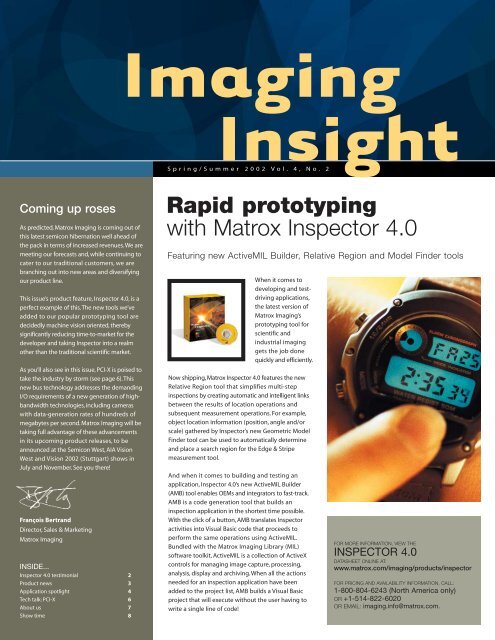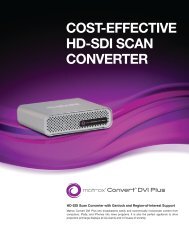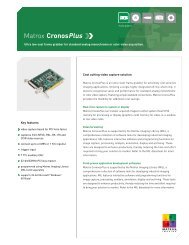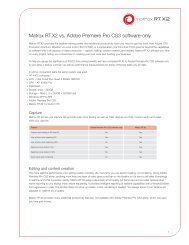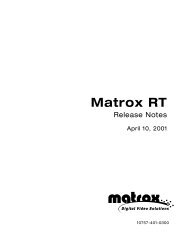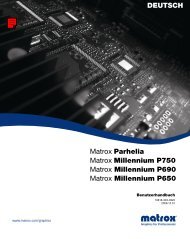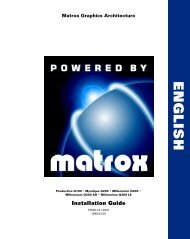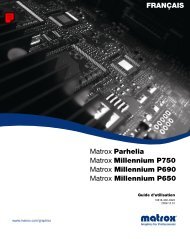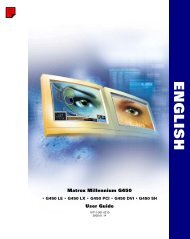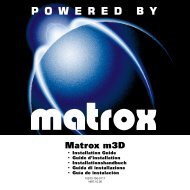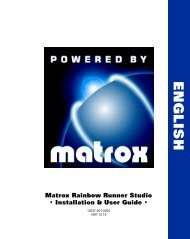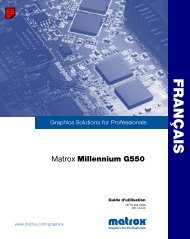Rapid prototyping with Matrox Inspector 4.0
Rapid prototyping with Matrox Inspector 4.0
Rapid prototyping with Matrox Inspector 4.0
You also want an ePaper? Increase the reach of your titles
YUMPU automatically turns print PDFs into web optimized ePapers that Google loves.
Coming up roses<br />
As predicted, <strong>Matrox</strong> Imaging is coming out of<br />
this latest semicon hibernation well ahead of<br />
the pack in terms of increased revenues.We are<br />
meeting our forecasts and, while continuing to<br />
cater to our traditional customers, we are<br />
branching out into new areas and diversifying<br />
our product line.<br />
This issue’s product feature, <strong>Inspector</strong> <strong>4.0</strong>, is a<br />
perfect example of this.The new tools we’ve<br />
added to our popular <strong>prototyping</strong> tool are<br />
decidedly machine vision oriented, thereby<br />
significantly reducing time-to-market for the<br />
developer and taking <strong>Inspector</strong> into a realm<br />
other than the traditional scientific market.<br />
As you’ll also see in this issue, PCI-X is poised to<br />
take the industry by storm (see page 6).This<br />
new bus technology addresses the demanding<br />
I/O requirements of a new generation of highbandwidth<br />
technologies, including cameras<br />
<strong>with</strong> data-generation rates of hundreds of<br />
megabytes per second. <strong>Matrox</strong> Imaging will be<br />
taking full advantage of these advancements<br />
in its upcoming product releases, to be<br />
announced at the Semicon West, AIA Vision<br />
West and Vision 2002 (Stuttgart) shows in<br />
July and November. See you there!<br />
François Bertrand<br />
Director, Sales & Marketing<br />
<strong>Matrox</strong> Imaging<br />
INSIDE...<br />
<strong>Inspector</strong> <strong>4.0</strong> testimonial 2<br />
Product news 3<br />
Application spotlight 4<br />
Tech talk: PCI-X 6<br />
About us 7<br />
Show time 8<br />
Imaging<br />
Insight<br />
Spring/Summer 2002 Vol. 4, No. 2<br />
<strong>Rapid</strong> <strong>prototyping</strong><br />
<strong>with</strong> <strong>Matrox</strong> <strong>Inspector</strong> <strong>4.0</strong><br />
Featuring new ActiveMIL Builder, Relative Region and Model Finder tools<br />
When it comes to<br />
developing and testdriving<br />
applications,<br />
the latest version of<br />
<strong>Matrox</strong> Imaging’s<br />
<strong>prototyping</strong> tool for<br />
scientific and<br />
industrial imaging<br />
gets the job done<br />
quickly and efficiently.<br />
Now shipping, <strong>Matrox</strong> <strong>Inspector</strong> <strong>4.0</strong> features the new<br />
Relative Region tool that simplifies multi-step<br />
inspections by creating automatic and intelligent links<br />
between the results of location operations and<br />
subsequent measurement operations. For example,<br />
object location information (position, angle and/or<br />
scale) gathered by <strong>Inspector</strong>’s new Geometric Model<br />
Finder tool can be used to automatically determine<br />
and place a search region for the Edge & Stripe<br />
measurement tool.<br />
And when it comes to building and testing an<br />
application, <strong>Inspector</strong> <strong>4.0</strong>’s new ActiveMIL Builder<br />
(AMB) tool enables OEMs and integrators to fast-track.<br />
AMB is a code generation tool that builds an<br />
inspection application in the shortest time possible.<br />
With the click of a button, AMB translates <strong>Inspector</strong><br />
activities into Visual Basic code that proceeds to<br />
perform the same operations using ActiveMIL.<br />
Bundled <strong>with</strong> the <strong>Matrox</strong> Imaging Library (MIL)<br />
software toolkit, ActiveMIL is a collection of ActiveX<br />
controls for managing image capture, processing,<br />
analysis, display and archiving. When all the actions<br />
needed for an inspection application have been<br />
added to the project list, AMB builds a Visual Basic<br />
project that will execute <strong>with</strong>out the user having to<br />
write a single line of code!<br />
FOR MORE INFORMATION, VIEW THE<br />
INSPECTOR <strong>4.0</strong><br />
DATASHEET ONLINE AT:<br />
www.matrox.com/imaging/products/inspector<br />
FOR PRICING AND AVAILABILITY INFORMATION, CALL:<br />
1-800-804-6243 (North America only)<br />
OR +1-514-822-6020<br />
OR EMAIL: imaging.info@matrox.com.
INSPECTOR <strong>4.0</strong><br />
What our customers are saying:<br />
Aerotech Inc. on <strong>Inspector</strong> <strong>4.0</strong><br />
Aerotech’s history of designing and<br />
manufacturing motion controllers, motors and<br />
drives began <strong>with</strong> its establishment in 1970.<br />
Today, hundreds of thousands of Aerotech<br />
components are used worldwide in factories and<br />
“With ActiveMIL Builder, we can bring<br />
code development down from a week to<br />
a day. We can build a new application<br />
and then add it to an existing MMI (manmachine<br />
interface) so that previous coding<br />
will not be lost in new developments.<br />
<strong>Rapid</strong> <strong>prototyping</strong> is truly what you get<br />
<strong>with</strong> <strong>Inspector</strong>.”<br />
– Tom Markel, Product Manager, Aerotech Inc.<br />
production facilities. Aerotech also manufactures<br />
a broad array of linear and rotary stages as well<br />
as advanced positioning mechanics for such<br />
industries as fiberoptics, semiconductor, imaging,<br />
laser machining and medical.<br />
“A large number of our customers integrate our<br />
motion products <strong>with</strong> machine vision for<br />
robotic guidance, fiberoptic component<br />
alignment, seam tracking, finding objects for<br />
laser welding, quality control inspection of<br />
parts and automated part alignment,” says<br />
Product Manager Tom Markel from Aerotech’s<br />
headquarters in Pittsburgh, Pennsylvania.<br />
“Typical systems require machine vision<br />
resolution at or below a micron per pixel. This<br />
year, we decided to offer our customers a set of<br />
machine vision tools for <strong>prototyping</strong> and<br />
implementing machine vision that worked <strong>with</strong><br />
our motion toolkits,” he adds.<br />
Aerotech developed two software toolkits, called<br />
AeroVision and Nview, to integrate <strong>with</strong> two of<br />
its motion controllers – the Unidex 500 (a PCI<br />
motion controller) and the Automation 3200<br />
software-only controller that runs in a real-time<br />
operating system <strong>with</strong> Aerotech’s new Firewire<br />
digital drives. Both toolkits integrated the <strong>Matrox</strong><br />
Imaging Library (MIL) <strong>with</strong> its own motion<br />
libraries for customer applications.This required<br />
customers to use <strong>Matrox</strong> <strong>Inspector</strong> 3.1 for vision<br />
<strong>prototyping</strong>. Customers grabbed images of the<br />
part being inspected, under various lighting<br />
conditions, and tested different methods for<br />
locating and inspecting the object. Once<br />
customers determined the proper inspection<br />
sequence for their application, they coded the<br />
process in Visual Basic or ‘C’ <strong>with</strong> MIL and then<br />
tested the application combined <strong>with</strong> motion.<br />
With the recent release of the latest version of<br />
<strong>Inspector</strong>, Aerotech is currently upgrading its<br />
toolkit to take advantage of <strong>Inspector</strong> <strong>4.0</strong>’s new<br />
machine vision tools, such as Geometric Model<br />
Finder, Relative Region and the ActiveMIL<br />
Builder code generation tool, says Markel.<br />
“With ActiveMIL Builder, we can bring code<br />
development down from a week to a day. We<br />
can build a new application and then add it to<br />
an existing MMI (man-machine interface) so<br />
that previous coding will not be lost in new<br />
developments. Geometric Model Finder is a<br />
great help for vision applications because the<br />
real world doesn’t always let the machine<br />
builder control the lighting well enough for<br />
correlation pattern matching. As for the<br />
Relative Region tool, it also helps the<br />
programmer by eliminating code that would<br />
be necessary to pass ROIs from one inspection<br />
tool to the next.”<br />
With <strong>Inspector</strong>, Aerotech customers are able to<br />
focus on the application instead of the<br />
programming, says Markel.“Having the vision<br />
tools and frame grabber controls readily<br />
available to experiment <strong>with</strong> – in a drag-anddrop,<br />
easy-to-use environment – not only<br />
speeds up the entire process but also helps the<br />
users quickly learn the different methods<br />
available for inspection.<br />
“<strong>Inspector</strong> is a great tool. There are a large<br />
number of features available and the user can<br />
very quickly determine what works and what<br />
doesn’t. <strong>Rapid</strong> <strong>prototyping</strong> is truly what you get<br />
<strong>with</strong> <strong>Inspector</strong>,” adds Markel.<br />
For more information on Aerotech products,<br />
visit http://www.aerotech.com.<br />
<strong>Matrox</strong> <strong>Inspector</strong> <strong>4.0</strong>’s<br />
new Model Finder tool for<br />
geometric pattern<br />
recognition quickly and<br />
accurately locates a model,<br />
or multiple models, at any<br />
position, angle and at any<br />
scale from 50-200 percent,<br />
under such harsh<br />
conditions as occlusion<br />
and non-uniform changes<br />
in contrast.
Meteor-II/Display for CompactPCI ®<br />
Imaging<br />
Insight<br />
Publisher: <strong>Matrox</strong> Imaging<br />
Editor: Kelly Davis<br />
Art Director: Jean Simard<br />
Marketing Communications: Catherine Overbury, Manager<br />
Reproduction in whole or in part, <strong>with</strong>out the prior written permission of <strong>Matrox</strong> Imaging, is prohibited.<br />
For more information on articles published in this issue, or to share your comments, please contact<br />
the Editor at 1-514-685-2630 ext. 7970 (tel), 1-514-822-6273 (fax) or email kdavis@matrox.com.<br />
All written comments or requests may be sent to:<br />
The Editor – Imaging Insight<br />
<strong>Matrox</strong> Imaging<br />
1055 St. Regis Blvd.<br />
Dorval, Quebec<br />
H9P 2T4 Canada<br />
PRODUCT NEWS<br />
Everyone needs a companion – even the Meteor-II for CompactPCI® frame grabber family from <strong>Matrox</strong> Imaging. Well look no<br />
further than our new Meteor-II/Display graphics card for CompactPCI®. Ideal for industrial applications, this companion board is<br />
based on the <strong>Matrox</strong> Millennium G550 graphics controller which boasts third-generation DualHead® display technology, 32 MB<br />
high-speed double data rate memory, UltraSharp 360 MHz primary RAMDAC, TV output and resolutions up to 2048 x 1536 in 32bit<br />
colour. With support for Windows® XP, 2000, NT, Me and 98, the new Meteor-II/Display for CompactPCI delivers exceptional<br />
graphics performance and product stability.<br />
MIL 7.0 under Windows XP Linux support for Meteor-II<br />
Did you know that MIL/MIL-Lite 7.0 has been successfully tested<br />
under Microsoft Windows XP? Contact your local representative or<br />
<strong>Matrox</strong> Imaging at 1-800-804-6243/+1-514-822-6020 or email:<br />
imaging.info@matrox.com for more details.<br />
4Sight-II <strong>with</strong> 1 GHz Pentium-III<br />
The 1 GHz Pentium-III has been successfully validated as a new option for the <strong>Matrox</strong> 4Sight-II industrial<br />
computer. Please contact your local representative or <strong>Matrox</strong> Imaging at 1-800-804-6243/+1-514-822-6020, or<br />
email: imaging.info@matrox.com for more details.<br />
Emlix GmbH of Germany has released version 0.9 of its Video for<br />
Linux Two (V4L2) driver for the Meteor-II and Meteor-II/Multi-Channel.<br />
This driver supports continuous streaming. For more information,<br />
please visit http://www.emlix.com/meteor2.<br />
Image Processing (point-to-point) Add two 8-bit images and store results in an 8-bit destination image.<br />
Image Processing (convolution, 3 x 3) Perform a general 3 x 3 convolution <strong>with</strong> arbitrary coefficients on an 8-bit<br />
1.7 ms 2.3 ms 1.7 ms 3.5 ms<br />
source image and store results in an 8-bit destination image. Results are saturated.<br />
Image Processing (compression JPEG Lossy) Perform lossy JPEG compression on an 8-bit source image and<br />
2.8 ms 3.2 ms 4.3 ms 5.2 ms<br />
store results in an 8-bit destination image.<br />
Pattern Matching (find a model) Find a 128 x 128 model in an 8-bit grayscale image.<br />
4.9 ms 5.9 ms 7.6 ms 8.8 ms<br />
The whole image is searched for a model that is not rotated.<br />
Geometric Model Finder (find a model) Find a single 128 x 128 model in an 8-bit image (1 model, 1 occurrence,<br />
2.2 ms 2.6 ms 2.6 ms 4.1 ms<br />
very high speed, limited scaling). The whole image is searched for a model rotated <strong>with</strong>in 0-360° and scaled <strong>with</strong>in 90-110%<br />
using the highest speed (lowest robustness and accuracy) setting.<br />
12.4 ms 15.6 ms 16.6 ms 24.5 ms<br />
OCR Reading (full read) Read an unknown string of twelve 33 x 21 characters (no grammar rules) <strong>with</strong>in a 404 x 54 image region. 65.3 ms 83.9 ms 107.8 ms 125.0 ms<br />
Please note that these benchmarks assume full CPU and memory bandwidth (i.e., no other system activity) and include system overhead.<br />
Operations were executed on 512 x 512 images, under Windows NT and MIL 7.0.<br />
Pentium ® III<br />
@ 1 GHz/<br />
100 MHz FSB<br />
Celeron ®<br />
@ 850 MHz/<br />
100 MHz FSB<br />
Pentium ® III<br />
@ 600 MHz/<br />
100 MHz FSB<br />
WANT TO SUBSCRIBE?<br />
GO TO: http://www.matrox.com/imaging/news_events/newsletter/subscribe.cfm<br />
Celeron ®<br />
@ 566 MHz/<br />
66 MHz FSB
APPLICATION SPOTLIGHT<br />
A watchful eye<br />
New ball-tracking technology<br />
from Roke Manor Research takes sports<br />
– and possibly umpiring – to a whole new level.<br />
By Kelly Davis, <strong>Matrox</strong> Imaging<br />
The game of cricket has been governed by a series of Codes and Laws for over 250 years,<br />
often subject to additions and alterations recommended by the ruling authorities of the time.<br />
And, like numerous other sporting activities, the game of cricket is not immune to current<br />
technological advancements. In fact, the International Cricket Council (ICC) is presently<br />
deliberating the use of a new ball-tracking system from Roke Manor Research that would aid<br />
umpires in making correct LBW (Leg Before Wicket) decisions.<br />
The LBW ruling has caused as many controversial moments in cricket as the offside ruling in<br />
football, the forward pass in rugby and line-call decisions in tennis. In fact, the LBW result<br />
determines a batsman’s innings and often the outcome of the game.<br />
For a batsman to be given out LBW, an initial call of ‘How’s that?’ must be given by a fielding<br />
player to the umpire, who in turn must decide whether or not the ball was travelling at such<br />
an angle that it would have hit the stumps, and whether or not it hit the pads before hitting<br />
the bat. The batsman would not be given out LBW if the point of contact between the pads<br />
and the ball was outside the line of off-stump or if the ball was pitched outside the leg-stump.<br />
This complicated ruling is not made any easier for the umpire by the fact that the average ball<br />
is travelling at 80mph from the bowler’s hand. It is no wonder that this is one of the trickiest<br />
decisions made in cricket and one that leaves plenty of room for uncertainty.<br />
Enter Hawk-Eye<br />
However, if adopted, a new technology called Hawk-Eye could erase all doubt from the minds<br />
of umpires, players and spectators by providing an analysis of the ball and wicket to <strong>with</strong>in an<br />
accuracy of 5mm.<br />
Invented by Dr. Paul Hawkins, a 27-year-old British<br />
scientist <strong>with</strong> Roke Manor Research near<br />
Southampton, Hawk-Eye incorporates image<br />
analysis and missile tracking technology. Six fixed<br />
JAI monochrome cameras, <strong>with</strong> a 120Hz frame rate,<br />
are placed around the playing field at key vantage<br />
points – two at each end at a 30 º angular<br />
displacement, and two side cameras (see diagram).<br />
These synchronized cameras track the ball’s entire<br />
trajectory – at intervals of every 1/100ths of a
After two years of development, Roke Manor Research’s Hawk-Eye technology went live at the<br />
Lord’s cricket match on April 21st, 2001, <strong>with</strong> great success. Shown here are three examples of<br />
the video images derived from information gathered by Hawk-Eye technology.<br />
second – from the moment it leaves the bowler’s<br />
hand until it stops.<br />
The six cameras are gen-locked into two sets of<br />
three cameras, each set being captured by a<br />
<strong>Matrox</strong> Meteor-II/Multi-Channel frame grabber<br />
and the <strong>Matrox</strong> Imaging Library (MIL-Lite)<br />
software. The resulting images are processed into<br />
a 3D image by the Hawk-Eye system which then<br />
calculates – in a split second – where the ball<br />
pitched, the extent of its lateral movement in the<br />
air and off the wicket, its velocity and bounce,<br />
and – if applicable – exactly where it contacted<br />
the batsman’s pad.<br />
The future path of the ball is also extrapolated by<br />
fitting the trajectory of the ball into a parametric<br />
model, thereby determining whether or not the<br />
ball would have carried on to hit the stumps,<br />
bounce over, or go past the wicket. Hawk-Eye<br />
then uses a <strong>Matrox</strong> Orion frame grabber to<br />
overlay a graphical representation of this<br />
trajectory onto a video image, which is encoded<br />
and transmitted to a video bank accessed by<br />
television producers.<br />
“A major challenge for us was transmitting the<br />
analog signal down the long cable lengths<br />
(ranging from 250-650 meters) of high-quality<br />
triax cable to the capture cards, <strong>with</strong>out losing<br />
the signal,” says Hawkins.“However, the MIL-Lite<br />
software was able to cope <strong>with</strong> the resultant<br />
signal degradation.”<br />
All of the information calculated by Hawk-Eye is<br />
available <strong>with</strong>in 1-2 seconds of the ball being<br />
bowled. This data could then be sent to umpires<br />
on the field using a transmission technology<br />
similar to local pagers or mobile telephones. Each<br />
umpire would carry a small, hand-held receiver<br />
<strong>with</strong> a display window that – <strong>with</strong>in four or five<br />
seconds – would give the umpire all the<br />
information he needs to make the LBW decision:<br />
whether the ball pitched outside the leg stump;<br />
whether the ball hit the batsman in line <strong>with</strong> the<br />
wickets; and whether the ball would have hit the<br />
stumps. Unlike the third umpire that is brought in<br />
to make a final decision when the first two<br />
umpires cannot agree, Hawk-Eye would not slow<br />
down the game, as it would determine the<br />
correct answer in less time than it would take for<br />
an umpire (or umpires) to make a decision.<br />
However, Hawkins stresses that Hawk-Eye “is<br />
being presented as an aid to the umpire, not as a<br />
threat to him. Umpires quite rightly will always<br />
be required.”<br />
In-depth coverage<br />
Although not yet in the hands of umpires, Hawk-<br />
Eye is already on the television screens and<br />
computer monitors of cricket fans around the<br />
world. Developed in conjunction <strong>with</strong> Channel 4,<br />
Hawk-Eye is credited <strong>with</strong> having revolutionized<br />
the way live cricket coverage is transmitted. In<br />
fact, Channel 4 competitor Sky Sports has already<br />
adopted the technology.<br />
Hawk-Eye information is being used by television<br />
broadcasters to present more in-depth coverage<br />
of cricket. It also allows cricket commentators to<br />
support their assessment of a batting or bowling<br />
performance <strong>with</strong> graphs and statistics. This will<br />
hopefully make cricket easier to understand and<br />
thus make it more attractive to a wider audience,<br />
says Hawkins.<br />
Hawk-Eye’s information is not only broadcasted<br />
to a television viewing audience but it is also<br />
uploaded to the cricket4.com web site. With this<br />
information, which is packaged as an interactive<br />
analysis tool (http://www.channel4.com/sport/<br />
cricket/analyst/hawkeye/about.html), users<br />
can produce their own data on how cricket’s top<br />
players are performing in the heat of Test cricket.<br />
With this technology, users can view where each<br />
ball pitched and passed the stumps, as well as<br />
analyze which areas have been most productive<br />
for each batsman and bowler. These statistics can<br />
be extended to cover the entire team’s<br />
performance, in any match.<br />
Not only cricket<br />
In partnership <strong>with</strong> Sunset + Vine, the television<br />
production company that produces Channel 4’s<br />
cricket coverage, Roke Manor Research has<br />
recently established Hawk-Eye Innovations Ltd.,<br />
an organization entirely dedicated to the<br />
development of similar technologies for wider<br />
sporting activities and applications. Games such<br />
as tennis, football, baseball and snooker can also<br />
be recreated on wireless devices, allowing<br />
viewers to watch a game from any location<br />
<strong>with</strong>out the need for the large bandwidth<br />
requirements of video broadcasting.<br />
In the meantime, as fans continue to enjoy this<br />
new perspective on cricket, the ICC has a tricky<br />
decision of its own to make – whether or not to<br />
bring this technology onto the cricket field and<br />
provide umpires <strong>with</strong> Hawk-Eye’s vision.<br />
For more information, visit:<br />
http://www.roke.co.uk/technology/innovations/<br />
Hawk_Eye.htm
TECH TALK<br />
6<br />
WITH PIERANTONIO BORIERO,<br />
PRODUCT LINE MANAGER FOR MATROX IMAGING<br />
3.3 Volt/64-bit PCI/PCI-X Slot<br />
3.3 Volt key<br />
5 Volt/64-bit PCI Slot<br />
32-bit 64-bit<br />
extension<br />
5 Volt key<br />
32-bit 64-bit<br />
extension<br />
Universal 64-bit Card Edge Connector<br />
3.3 Volt key slot 5 Volt key slot<br />
32-bit 64-bit<br />
extension<br />
No more<br />
bottlenecks<br />
<strong>with</strong> PCI-X<br />
PCI-X is a high-performance enhancement to the conventional PCI bus<br />
specification. This technology, <strong>with</strong> its increased performance, addresses<br />
the demanding I/O requirements for a new generation of high-bandwidth<br />
applications like Gigabit Ethernet and high-speed CameraLink cameras.<br />
Version 1.0 of PCI-X specifies a 64-bit connection running at speeds of 66,<br />
100 or 133 MHz, resulting in a peak bandwidth of 528, 800 or 1064<br />
Megabytes per second, respectively.<br />
Equally important, PCI-X provides backward compatibility by allowing devices<br />
to operate at conventional PCI frequencies and modes when installed in such<br />
systems. PCI-X peripheral cards can operate in a conventional PCI slot,<br />
although only at PCI rates and may require a 3.3 V conventional PCI slot.<br />
Similarly, a PCI peripheral card <strong>with</strong> a 3.3 V or universal card edge connector<br />
can operate in a PCI-X slot, however the bus clock will remain at a frequency<br />
acceptable to the PCI card.<br />
However, as <strong>with</strong> many technologies, there is a trade-off. In the case of PCI-X,<br />
speed is sacrificed as the number of slots per bus segment increases. A bus<br />
segment is loosely defined as the number of slots emanating from or<br />
between bridges. A 66 MHz operation allows a maximum of four slots per bus<br />
segment (compared <strong>with</strong> a maximum of two slots for 66 MHz conventional<br />
PCI). A 100 MHz operation allows a maximum two slots per bus segment,<br />
while a 133 MHz operation allows a maximum of one slot per bus segment.<br />
Server and workstation class systems and motherboards are starting to<br />
make their appearance <strong>with</strong> PCI-X equipped core logic chipsets such as<br />
the ServerWorks Grand Champion series, Intel® E7500 and the soon-toarrive<br />
AMD-8000 Series. The ePCI-X specification from the PCI Industrial<br />
Computer Manufacturers Group (PICMG) will pave the way for industrial<br />
PCs <strong>with</strong> PCI-X slots.<br />
PCI-X doesn’t stop at Version 1.0. Version 2.0 is currently being drafted by the<br />
PCI Special Interest Group (PCISIG) – the organization that created and now<br />
maintains PCI-X and conventional PCI – and this version promises to double<br />
and quadruple the current bandwidth allowances.<br />
And stay tuned as <strong>Matrox</strong> Imaging will soon be announcing an exciting new<br />
generation of frame grabbers and vision processors that take advantage of<br />
PCI-X technology!
MIL Pattern Recognition training now offered<br />
MIL Processing Software Leader Stephane<br />
Baldo (left) helps out a customer at the last<br />
MIL training in Montreal, Québec.<br />
<strong>Matrox</strong> Imaging introduces its new <strong>Matrox</strong> Imaging<br />
Library (MIL) Pattern Recognition Training. This 3-day<br />
intensive training teaches you how to select the best<br />
technology for your application, whether it be<br />
normalized greyscale correlation or geometric pattern<br />
recognition, and how to use the chosen algorithm to<br />
its full potential.<br />
This training includes a general introduction to the<br />
MIL/MIL-Lite environment, in-depth training on MIL's<br />
normalized greyscale correlation pattern matching<br />
module and its new Geometric Model Finder module.<br />
"Hands-on" workshops and Question & Answer<br />
periods <strong>with</strong> the scientists that developed these<br />
algorithms will ensure that you leave the training <strong>with</strong><br />
the knowledge needed to solve real-world<br />
applications!<br />
For more information on this or our MIL/MIL-Lite<br />
Environment training seminar, email<br />
imaging.training@matrox.com, call 1-800-804-6243 or<br />
visit: http://www.matrox.com/imaging/<br />
training/mil-lite/home.cfm<br />
<strong>Matrox</strong> Imaging<br />
Demonstration Days in Europe<br />
WHAT: <strong>Matrox</strong> <strong>Inspector</strong> <strong>4.0</strong> Demonstration Day<br />
WHERE: <strong>Matrox</strong> Imaging UK headquarters, Sefton Park, Stoke Poges,<br />
Buckinghamshire, UK<br />
WHEN: Wednesday, June 12, 2002, 10h00-13h00, free buffet included<br />
WHY: Discover how to prototype and develop your application in record time<br />
using <strong>Inspector</strong> <strong>4.0</strong> software, including the new ActiveMIL Builder tool. All<br />
attendees will have a chance to win a FREE copy of <strong>Inspector</strong> <strong>4.0</strong>!<br />
HOW TO REGISTER:<br />
Visit http://www.matrox.com/imaging/inv/uk/<br />
E-mail image.info.emea@matrox.com<br />
Call +44 (0)1753 665511<br />
Fax +44 (0)1753 665597<br />
WHAT: <strong>Matrox</strong> Imaging Technology Day<br />
WHERE: Munich, Germany<br />
WHEN: Friday, June 14, 2002, 09h30-14h30, free lunch included<br />
WHY: Learn how <strong>Matrox</strong> Imaging technology can help you develop your nextgeneration<br />
vision system. The day will include demonstrations of our latest<br />
hardware and software products, plus an opportunity to speak one-on-one<br />
<strong>with</strong> our engineers.<br />
HOW TO REGISTER:<br />
Visit http://www.matrox.com/imaging/inv/de/<br />
E-mail technology.day@matrox.com<br />
Call +49 (0) 89 62170 520<br />
Fax +49 (0) 89 6149 743<br />
ABOUT US<br />
AUTUMN 2002<br />
TRAINING SCHEDULE<br />
MATROX IMAGING LIBRARY (MIL)<br />
PATTERN RECOGNITION TRAINING<br />
September 17-19<br />
(September 20 is an optional half-day)<br />
<strong>Matrox</strong> Corporate Headquarters<br />
Dorval, Québec, Canada<br />
Tuition: $2,495 USD/$3,750 CDN per person<br />
INTRODUCTION TO THE<br />
MIL/MIL-LITE ENVIRONMENT<br />
September 10-12<br />
(September 13 is an optional half-day)<br />
<strong>Matrox</strong> Corporate Headquarters<br />
Dorval, Québec, Canada<br />
Tuition: $1,995 USD/$2,995 CDN per person<br />
Can’t come to us? Then let us come to you.<br />
Certain training programs are offered on-site,<br />
so give us a call!<br />
7
IMAGING ONLINE<br />
<strong>Inspector</strong> <strong>4.0</strong> evaluation CD<br />
now available<br />
SHOW TIME<br />
Applications engineer Jon Abitz helps out a<br />
visitor to the <strong>Matrox</strong> Imaging booth at IPOT<br />
2002 in Birmingham, UK.<br />
In tandem <strong>with</strong> the release of the <strong>Matrox</strong> <strong>Inspector</strong> <strong>4.0</strong> software,<br />
<strong>Matrox</strong> Imaging has created a 30-day evaluation CD for <strong>Inspector</strong> <strong>4.0</strong>.<br />
Copies of this evaluation CD may be ordered by visiting<br />
http://www.matrox.com/imaging/reg/inspdemo.<br />
Tracking RMAs online<br />
Canadian and US customers can now request and track their RMAs (Return Merchandise Authorizations) on-line.<br />
Requests for returns or exchanges of <strong>Matrox</strong> Imaging products can now be submitted via an on-line RMA form,<br />
located at: http://rma.matrox.com. After customers request their RMA numbers, these numbers, along <strong>with</strong><br />
instructions explaining how to return the merchandise, are e-mailed to them 24-48 business hours after receipt of<br />
their on-line requests. Customers may also track the progress of their RMA requests on-line. Currently, the on-line<br />
RMA procedure is available to Canadian and US customers only, however we do offer online RMA support<br />
information to our international customers which can be accessed through the support page of the Imaging web<br />
site: http://www.matrox.com/imaging/support/.<br />
New application notes available<br />
Be sure to check out our new application notes under the Interfacing Cameras section of our website at<br />
http://www.matrox.com/imaging/cameras/appnotes.cfm.These include notes on the CIS VCC-265EIR camera for<br />
the <strong>Matrox</strong> Corona-II and <strong>Matrox</strong> Meteor-II/Multi-Channel, the BASLER A202b for the <strong>Matrox</strong> Meteor-II/Camera Link<br />
and the BASLER A202bc for the <strong>Matrox</strong> Meteor-II/Camera Link.<br />
See <strong>Matrox</strong> Imaging and its representatives at the following events:<br />
Semicon West 2002<br />
July 17-19, 2002<br />
San Jose, CA<br />
'02 Exhibition on Sensing via Image<br />
Information<br />
July 17-19, 2002<br />
Yokohama, Japan<br />
Rep: Sumitomo Metal System<br />
Solutions CO., Ltd.<br />
Go.Automation.Days<br />
Sept. 3-Sept. 9, 2002<br />
Basel, Switzerland<br />
Rep: Fabrimex AG<br />
Corporate headquarters:<br />
Canada and U.S.A.<br />
<strong>Matrox</strong> Electronic Systems Ltd.<br />
1055 St. Regis Blvd.<br />
Dorval, Quebec H9P 2T4<br />
Canada<br />
Tel: +1 (514) 685-2630<br />
Fax: +1 (514) 822-6273<br />
Offices:<br />
Europe, Middle East & Africa<br />
<strong>Matrox</strong> VITE Limited<br />
Sefton Park<br />
Stoke Poges<br />
Buckinghamshire<br />
SL2 4JS, U.K.<br />
Tel: +44 (0) 1753 665511<br />
Fax: +44 (0) 1753 665597<br />
Opto / Physique / Capteurs<br />
October 22-24, 2002<br />
Paris, France<br />
Rep: I2S<br />
The 8th International Lasers,<br />
Optoelectronics and Photonics<br />
Exhibtion<br />
Nov. 6-9, 2002<br />
Beijing, China<br />
Rep: Beijing Microview Electronic<br />
Technology Co., Ltd.<br />
Vision 2002<br />
November 12-14, 2002<br />
Stuttgart, Germany<br />
France<br />
<strong>Matrox</strong> France SARL<br />
2, rue de la Couture<br />
Silic 225<br />
94528 Rungis Cedex<br />
Tel: (0) 1 45-60-62-00<br />
Fax: (0) 1 45-60-62-05<br />
NEED TICKETS<br />
OR MORE INFO?<br />
Contact:<br />
+1 (514) 685-2630 ext. 7638<br />
email: adhindsa@matrox.com<br />
For more information on these shows<br />
and seminars, visit:<br />
http://www.matrox.com/imaging/<br />
news_events/events/<br />
Germany<br />
© <strong>Matrox</strong> Imaging<br />
<strong>Matrox</strong> Electronic<br />
Systems GmbH Printed in Canada<br />
Inselkammerstr. 8 $IE-5261-B<br />
D-82008 Unterhaching<br />
Germany<br />
Tel: 089/614 4740<br />
Fax: 089/614 9743


